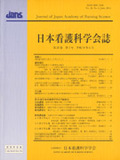Japanese
English
- 販売していません
- Abstract 文献概要
- 参考文献 Reference
- サイト内被引用 Cited by
要旨
目的:精神科訪問看護で提供されたケアをもとに利用者の類型化を行い,それぞれの類型のケアがどのような対象に提供されているのかを記述する.
方法:訪問看護ステーション322事業所において統合失調症患者422名に提供されたケアの内容を22項目からなるケア得点で測定し,クラスター分析を用いて対象者を4群に分類した.次に,各群の特徴を明らかにするため,一元配置分散分析(群間の対比較にはTukeyの多重比較),x2検定によって群間比較を行った.
結果:精神科訪問看護で提供されたケア内容の特徴によって対象者を分類した結果,「独居者援助型」「重症者への家族援助型」「他援助がある人へのモニタリング重視型」「重症者への本人援助型」に分類でき,同居者の有無,社会機能の程度,訪問看護以外の援助者の有無において群間に差が認められた.
結論:精神科訪問看護の利用者とケア提供パターンを類型化することができた.独居者への援助,重症者への家族援助および本人への援助,モニタリングの4つに特化した支援が行われている利用者群があることが示された.
Abstract
Purpose: This research aimed to classify the service delivery pattern by home-visiting nurses for people with schizophrenia living in Japan.
Method: Nursing care delivered to schizophrenic patients (n=422) from 322 Japanese home visiting nursing stations and patients' characteristics were examined. The care scores of the 22 psychiatric nursing care categories were classified by cluster analysis. One-way analysis of variance and x2 test were used to examine the characteristics of patients and the care category clusters they received.
Result: Four characteristic clusters emerged: care for living alone; family support for patients who had severe conditions; monitoring for who had other support and support for patients with severe conditions. The ratio of who had a housemate (p<0.001), support from non-nurse (home help, p<0.05), and social functioning (GAF: Global Assessment of Functioning, P<0.01) showed significant differences between the clusters.
Conclusions: Characteristics of home visiting nurse users who had schizophrenia and their care delivery patterns were classified. Four significant care areas emerged, care for living alone, family and the patients' support for severe conditions, and monitoring.
Copyright © 2012, Japan Academy of Nursing Science. All rights reserved.


